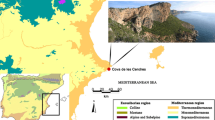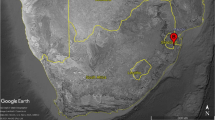Abstract
This research is the first attempt to study the wood charcoal remains for several mounds and domestic archaeological sites found in the valleys of Purén, Lumaco, and PucÓÓn, and offers information complementary to that from previous studies such as pollen deposition in wetlands near archaeological sites and the presence of carbonized fruits and seeds in archaeological contexts.
Access this chapter
Tax calculation will be finalised at checkout
Purchases are for personal use only
Similar content being viewed by others
Notes
- 1.
Microscopic identification of the wood charcoal did not always lead to the identification of the material at species level. This was subject to anatomical features within a particular genus, which can be affected by hybridization; in this case, both species are indicated (Nothofagus obliqua–alpina), or when less certain, the sample was given a comparative qualifier and cf. is indicated before the name (e.g., cf. Laurelia sempervirens). If the identification is only to generic level, the abbreviation sp. is written after the genus (e.g., Nothofagus sp.). Given the great variability within the identifications, the whole group is called taxon and includes all the previous categories as well as the families (i.e., Proteaceae and Myrtaceae).
- 2.
Gymnosperm with secretor channels.
- 3.
Radiocarbon dates and relative dating of ceramics.
- 4.
It is hypothesized that the impact of human activity in PucÓn was lesser on the natural landscape.
- 5.
The subject was discussed in the workshop in Rennes, France (2001), and no consensus was reached regarding the cause of crystallization—vitrification of the samples. For some, this is associated with the type of species and their components, while for others, it is related to the small diameter or combustion of the material
References
Abarzúa, A. M. A., Jarpa, L., Martel, A., Vega, R., Pino, M. (2007). Informe trabajo realizadoen el Valle de Purén Lumaco. Instituto de Geociencias, UACh.
Bengoa, J. (2003). Historia de los antiguos mapuches del sur. Desde antes de la llegada de los españoles hasta las paces de Quilín. Santiago: Ed. Catalonia.
Camus, P. (2006). Ambiente, bosque y gestión forestal en Chile: 1541–2005. Santiago: Ed. Lom.
Chabal, L., Fabre, L., Terral, J. F., Théry-Parisot, I. (1999). L’anthracologie. In C. Bourquin-Mignot, et al. (ed.), La Botanique (pp. 43–104). Paris: Editions Errance.
Donoso, C. (1993). Bosques templados de Chile y Argentina. Variación, estructura y dinámica. Santiago: Ed. Universitaria.
Hoffmann, A. (1982). Flora silvestre de Chile. Zona Araucana. Ärboles, arbustos y enredaderas leñosas. Santiago: E. Fundación C. Gay.
Lehnebach, C., Solari, M. E., Adán, L., Mera, R. (2008). Plant macro-remains from a rockshelter in the temperate forests of Central-South Chile (39° S). Vegetation History and Archaeobotany, 17, 403–413.
Rancusi, M., Nishida, M., Nishida, H. (1987). Xylotomy of important Chilean woods. In M. Nishida (ed.), Contributions to the botany in the Andes II, (pp. 68-158). Tokyo: Ed. Academia Scientific Book.
Silva, C. (2005). Informe de análisis carpológico sobre muestras provenientes desde los cuel de Lumaco y Purén. Región de la Araucanía. Report submitted to the Proyecto Purén-Lumaco, Nashville, TN: Vanderbilt University.
Solari, M. E. (1993). L’homme et le bois en Patagonie et Terre de Feu au cours des six derniers millénaires: recherches anthracologiques au Chili et en Argentine. Thèse de Doctorat. Université de Montpellier II.
Solari, M. Eugenia, & Lehnebach, C. (2004). Pensando la antracología para el centro-sur de Chile: Sitios arqueológicos y bosque en el lago Calafquén (IX-X región). Revista Chungará, 1, 373–380.
Wagemann, W. (1949). Maderas chilenas: contribución a su anatomía e identificación. De Lilloa, XVI, 304–350.
Author information
Authors and Affiliations
Rights and permissions
Copyright information
© 2014 Springer International Publishing Switzerland
About this chapter
Cite this chapter
Solari, M. (2014). Appendix 3: Analysis of Wood Charcoal Remains from Kuel and Domestic Sites. In: The Teleoscopic Polity. Contributions To Global Historical Archaeology, vol 38. Springer, Cham. https://doi.org/10.1007/978-3-319-03128-6_14
Download citation
DOI: https://doi.org/10.1007/978-3-319-03128-6_14
Published:
Publisher Name: Springer, Cham
Print ISBN: 978-3-319-03127-9
Online ISBN: 978-3-319-03128-6
eBook Packages: Humanities, Social Sciences and LawSocial Sciences (R0)




